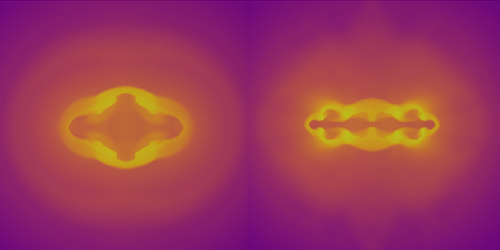Strong Magnetization Flattens a Fusion Implosion
In nuclear fusion, very high temperatures and pressures force nuclei to overcome their mutual electrostatic repulsion and merge together, releasing energy. These conditions are achieved in inertial-confinement fusion—a method that involves using powerful lasers to rapidly implode a millimeter-sized fuel capsule and produce a plasma. Now, Arijit Bose at the Massachusetts Institute of Technology and his colleagues have uncovered how the shape of this implosion is affected when a strong magnetic field is applied to the capsule [1]. The result suggests that such a field could increase the power generated in inertial-fusion experiments.
Previous work found that the implosion shape was not discernibly altered by an external magnetic field with a strength of up to about 8 T. But calculations indicate that higher fields might have an impact by strongly magnetizing the plasma’s electrons and ions. Therefore, Bose and his colleagues carried out inertial-fusion experiments using a 50-T magnetic field at the OMEGA laser facility, University of Rochester, New York. They found that this field flattened the shape of the implosion, such that it became more oblate. Through simulations, the team determined that this oblate shape is caused by the suppression of heat flow—perpendicular to the direction of the magnetic field—in the strongly magnetized plasma.
These findings demonstrate that a powerful magnetic field can impact both the thermal transport and the shape of an inertial-fusion implosion, which could potentially change its energy output. Moreover, the researchers say that their work provides a new way to generate strongly magnetized electrons and ions.
–Ryan Wilkinson
Ryan Wilkinson is a Corresponding Editor for Physics Magazine based in Durham, UK.
References
- A. Bose et al., “Effect of strongly magnetized electrons and ions on heat flow and symmetry of inertial fusion implosions,” Phys. Rev. Lett. 128, 195002 (2022).




